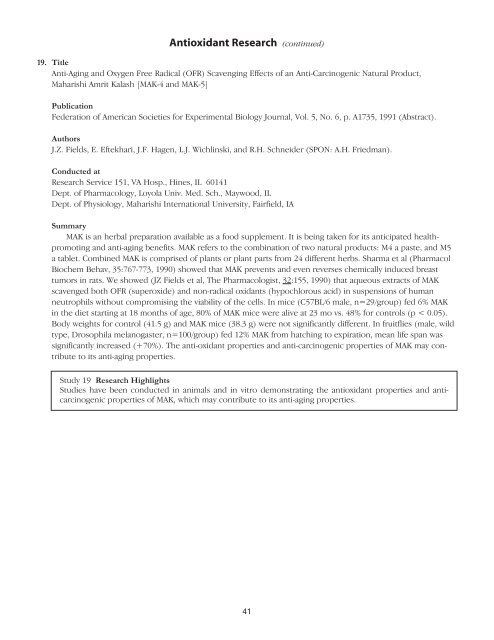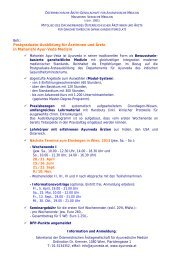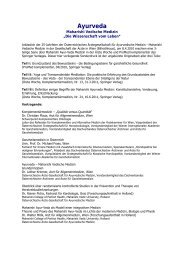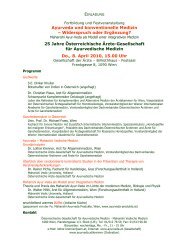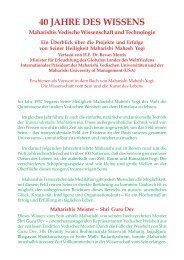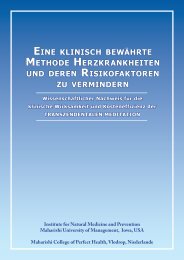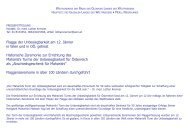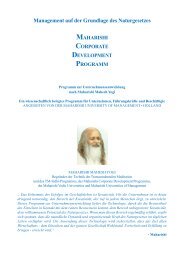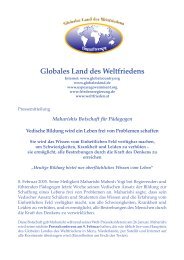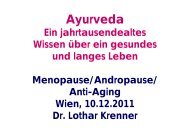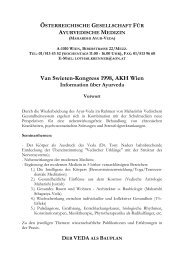Summary of Research Findings
Summary of Research Findings
Summary of Research Findings
Create successful ePaper yourself
Turn your PDF publications into a flip-book with our unique Google optimized e-Paper software.
Antioxidant <strong>Research</strong> (continued)<br />
19. Title<br />
Anti-Aging and Oxygen Free Radical (OFR) Scavenging Effects <strong>of</strong> an Anti-Carcinogenic Natural Product,<br />
Maharishi Amrit Kalash [MAK-4 and MAK-5]<br />
Publication<br />
Federation <strong>of</strong> American Societies for Experimental Biology Journal, Vol. 5, No. 6, p. A1735, 1991 (Abstract).<br />
Authors<br />
J.Z. Fields, E. Eftekhari, J.F. Hagen, L.J. Wichlinski, and R.H. Schneider (SPON: A.H. Friedman).<br />
Conducted at<br />
<strong>Research</strong> Service 151, VA Hosp., Hines, IL 60141<br />
Dept. <strong>of</strong> Pharmacology, Loyola Univ. Med. Sch., Maywood, IL<br />
Dept. <strong>of</strong> Physiology, Maharishi International University, Fairfield, IA<br />
<strong>Summary</strong><br />
MAK is an herbal preparation available as a food supplement. It is being taken for its anticipated healthpromoting<br />
and anti-aging benefits. MAK refers to the combination <strong>of</strong> two natural products: M4 a paste, and M5<br />
a tablet. Combined MAK is comprised <strong>of</strong> plants or plant parts from 24 different herbs. Sharma et al (Pharmacol<br />
Biochem Behav, 35:767-773, 1990) showed that MAK prevents and even reverses chemically induced breast<br />
tumors in rats. We showed (JZ Fields et al, The Pharmacologist, 32:155, 1990) that aqueous extracts <strong>of</strong> MAK<br />
scavenged both OFR (superoxide) and non-radical oxidants (hypochlorous acid) in suspensions <strong>of</strong> human<br />
neutrophils without compromising the viability <strong>of</strong> the cells. In mice (C57BL/6 male, n=29/group) fed 6% MAK<br />
in the diet starting at 18 months <strong>of</strong> age, 80% <strong>of</strong> MAK mice were alive at 23 mo vs. 48% for controls (p < 0.05).<br />
Body weights for control (41.5 g) and MAK mice (38.3 g) were not significantly different. In fruitflies (male, wild<br />
type, Drosophila melanogaster, n=100/group) fed 12% MAK from hatching to expiration, mean life span was<br />
significantly increased (+70%). The anti-oxidant properties and anti-carcinogenic properties <strong>of</strong> MAK may contribute<br />
to its anti-aging properties.<br />
Study 19 <strong>Research</strong> Highlights<br />
Studies have been conducted in animals and in vitro demonstrating the antioxidant properties and anticarcinogenic<br />
properties <strong>of</strong> MAK, which may contribute to its anti-aging properties.<br />
41


